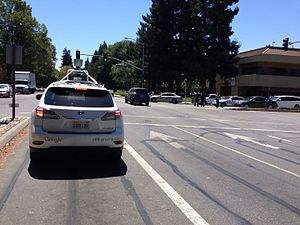ICT student textbook/Introduction
What is ICT
Have you ever seen anyone in your school or community or home use a phone? Have you ever withdrawn money from an ATM (Automated Teller Machines, also known as 'Any time money'), or seen someone get money from an ATM? You may have seen or helped someone book a gas cylinder refill through a phone. You may perhaps have booked a train ticket or booked Tirumala darshan on-line. You may have seen a movie on your computer or chatted with a friend or recorded a video with your phone. Have you ever wondered how these things are done? There is one thing common that is common across all these things - the use of Information Communication Technologies, ICT.
Before we understand what are ICT, look at the list below and identify all the words that you have heard of: File:Have you heard of ICT terms.mm (If you are using the printed book, please open the file "Have_you_heard_of_ICT_terms.mm" using Freeplane).
As students, you have been introduced to some or many of these terms in your school, in your family or in your neighbourhood. The cell phone tower, your nearest ATM, your mother's mobile phone, games, whatsapp chats, email, the selfie, internet, videos and songs on your computer - all these are examples of a new kind of ICT. These technologies are called digital technologies and they are changing the way we talk to each other, work with each other, and the way we do things. The computer is becoming like a television, the phone is becoming like a computer, you can use the computer to make voice calls, you can record a video with your phone, you can read your newspaper on the phone, and you can even paint with your computer!
The technologies that make all these possible are collectively called ICT. ICT refers to those set of technologies that help us create information, access information, analyze information and communicate with each other. Human beings have always accessed information and communicated, but what makes these present technologies special is their digital nature. You can read more about how ICT developed in the chapter on Science, Technology and Society.
We live in an information society
Look at the pictures below and discuss with your friends and teacher.
| What is this bonobo doing - can you guess? You are correct! It is "fishing" for termites from an ant hill.
| |
| What is special about this car? Did you guess? Yes, it has no driver.
|
Today's society is called the information society. To see why, let us do a small activity.
Let us say you are withdrawing money from a nearby ATM. Can you make a list of all the information requirements for doing that activity? That is correct, you need your account number, your PIN and you need to enter the amount of money. When you put your card in the machine, it collects information about your bank account, the bank and the balance amount. The ATM machine verifies your PIN with the bank and allows you to withdraw the money.
So many things we do now are based on information. How we collect information, how we analyze it, how we communicate the information and how we use the information to make decisions are all very important. Many devices - mobile phones, television, computers, tablets, cameras, scanners, collectively called ICTs, have made this possible. ICT and broadly digital technologies are changing the way we talk, we learn and we work. ICT can help us create, draw, compose music,communicate and do so much more. You may be familiar with the computer but now ICT have moved far beyond the mere computer. As students you have to learn ICT to build your skills for functioning in the information society.
What can you expect to learn
ICT can help you create music, write poetry, learn mathematics or make videos. ICT can also help you in communicating with each other and learning together. The syllabus has been developed to introduce you to all these possibilities.
In this new subject called ICT, we can expect to learn about the nature of ICT and how to work with ICT; this will be covered over a 3 year period. The subject has a knowledge component and a skill component.
Knowledge component
This subject will introduce you to:
- What is ICT
- How did ICT develop
- Effect ICT has on family, neighbourhood, school and village
- Use of ICT ethically, safely and responsibly
Skill component
As a part of this subject, through different hands-on activities and projects you will learn to:
- Use ICT to express your ideas, using available resources (using images, audio, text, videos)
- Use ICT to learn school subjects and improve your general knowledge
- Use ICT to talk to your friends, to work together and to play together
- Use ICT to help in the development of the local community, socio cultural activities and development.
This textbook will introduce you to the various possibilities of learning and doing and communicating that are possible now with ICT. As students, you are encouraged to explore this new area and make connections to your own daily life, the impact these ICT have on your life, how you would like to work with this technology and how you can equip yourself to understand this new way of thinking, learning and communicating.
How is this book organized
Units of study
The textbook will have 5 units:
- What is the nature of ICT
- Data representation and processing
- Communication with graphics
- Audio visual communication
- Learn your school subjects
- Each unit has a brief introduction followed by hands-on activities and lessons for each unit. Each of the units will present ideas and activities at three different levels to address the classes 6-8 and your teacher will determine the appropriate level of activity. We will be required to work on projects, individually or in groups, to explore a particular idea or a problem. Different ICT devices, tools and methods will be used in this.
- Your teacher will introduce a new unit or an idea with a unit with an activity in class. As part of this activity, you will be working with an ICT device or an application; your teacher will show you how to use the ICT device or application. Instructions for learning an application are available here.
- There will be hands-on projects for working with different applications. You will do the projects with your friends, read the textbook and discuss in the classroom. Different groups in the class will work on different examples for a given theme and share their analysis, findings and creations. You will learn together and teach one another!
Online and offline distribution
- On-line : The entire textbook is available on the Internet here. You can access the chapters, resources, activities and practise on your computer. All resources - whether open content or proprietary content - will be accessible. However, you need continuous Internet connectivity for accessing the on-line version of the book.
- Off-line : The entire textbook is available off-line in your school. You can access the chapters, resources, activities and practise on your computer with one limitation. Only open content will be available for you to access offline in your school. However the textbook will show the internet links for the proprietary content and this can be accessed whenever there is internet connectivity.
- Print edition : The print edition is a limited edition of the book which will give the textual version of the textbook. The text version is only meant for introductory/ classroom discussions on a unit and will have to refer to the off-line textbook for the actual ICT resources used for a activity. All resources used in the textbook will be listed in the print version under the references section.

